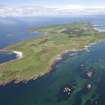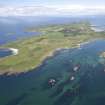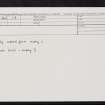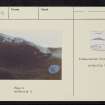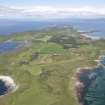Gigha, Ardminish
Cist (Bronze Age), Knife (Flint)(Bronze Age)
Site Name Gigha, Ardminish
Classification Cist (Bronze Age), Knife (Flint)(Bronze Age)
Canmore ID 38528
Site Number NR64NW 19
NGR NR 6495 4890
Datum OSGB36 - NGR
Permalink http://canmore.org.uk/site/38528
- Council Argyll And Bute
- Parish Gigha And Cara
- Former Region Strathclyde
- Former District Argyll And Bute
- Former County Argyll
NR64NW 19 6495 4890
(NR 6496 4890) (information from R E MacCallum Ts, 1962) A short cist, found during quarrying of rock outcrop about 18m north of the schoolhouse at Ardminish, can still be seen set into the west side of the small, turf-covered knoll. Soon after it was found, on 3 July 1924, it was examined by Ludovic Mann, who discovered a plano-convex flint knife. The cist is still fairly complete except for the west side-slab, which has been dislodged and lies at the foot of the knoll. The north end-slab and the east side-slab, now broken, are still in situ, but the south end-slab has collapsed. The cover-slab appears to be in its original position, and the floor is of natural rock.
The knife is now in Glasgow Art Gallery and Museum.
RCAHMS 1971.
The cist is as described by the previous authorities.
Surveyed at 1:2500.
Visited by OS (J B) 20 January 1978.
Field Visit (May 1963)
Cist, Ardminish, Gigha.
The remains of a short cist can be seen set into the W. side of a small turf covered knoll some 18 m N. of the schoolhouse at Ardminish. Originally discovered during quarrying operations (Anderson, 30), the cist is still fairly complete except for the W. side-slab, which has been dislodged and lies at the foot of the knoll. The internal dimensions are 0.8 m by 0.6 m and 0.5 m in depth, the longer axis being aligned approximately N. and S. The N. end-slab and the E. side-slab (now broken) are still in situ, but the S. end slab has collapsed. The cover slab, which appears to be in its original position, measures 1.1 m by 0.7 m and 0.2 m in thickness; the floor is composed of the natural rock. A plano-convex flint knife, which came from the cist at the time of its initial discovery, is now in Glasgow Art Gallery and Museum.
RCAHMS 1971, visited May 1963.
649489 ccxxv (unnoted)













